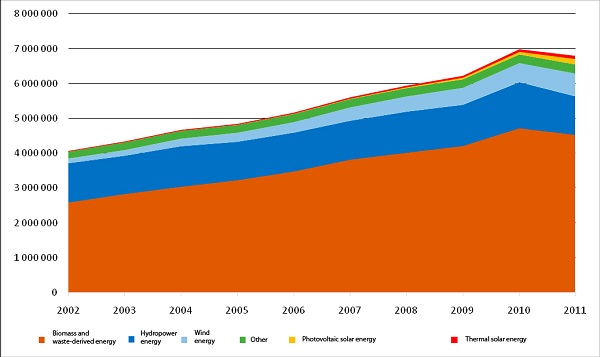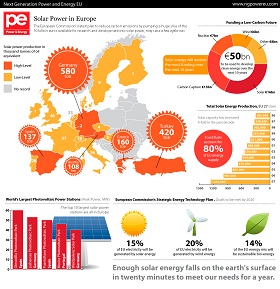Renewable Energy in the EU: Change of Priorities
In
Login if you are already registered
(votes: 1, rating: 5) |
(1 vote) |
Political Science PhD, associate professor, head of department of European integration at MGIMO-University, leading research fellow at the RAS Institute of Europe
Despite impressive technological progress, renewable energy remains largely uncompetitive with conventional energy sources. The reason for the rapid development of renewable energy in the European Union has been primarily large-scale government support. Currently, the EU is modifying its strategy for renewable energy in order to reduce the share of support it offers. This will inevitably lead to a sharp reduction in the development of renewable energy, a failure to reach previously agreed-upon targets and the continuation of the current dependence on imported hydrocarbons.
Despite impressive technological progress, renewable energy remains largely uncompetitive with conventional energy sources. The reason for the rapid development of renewable energy in the European Union has been primarily large-scale government support. During the economic crisis, these subsidies have become a heavy burden on EU budgets and the wider population. Currently, the EU is modifying its strategy for renewable energy in order to reduce the share of support it offers. This will inevitably lead to a sharp reduction in the development of renewable energy, a failure to reach previously agreed-upon targets and the continuation of the current dependence on imported hydrocarbons.
The European Union is one of the world leaders in the development of renewable energy sources (RES). According to BP, the share of the EU accounts for nearly 42 percent of global consumption of renewable energy, while in the U.S., the corresponding figure is 23 percent, in China – 9 percent, and in Japan – only 4 percent (bp.com/statisticalreview). Over the past 15 years the EU has shaped a comprehensive policy of stimulating renewable energy development, including putting forth clearly defined goals, a wide range of measures to achieve them and a specific model of dividing responsibilities between the communitarian and national levels of government. In the mid-2000s, the European Union adopted an integrated approach based on a package of climate and energy measures and set targets for achieving a 20 percent share of renewable energy in final energy consumption by 2020 [4]. To reach the stated goal, in 2009 the Directive of the European Parliament and of the Council of 23 April 2009 on the promotion of the use of energy from renewable sources [2] was adopted, making political intentions into legal obligations. In 2002-2011, the total production of renewable energy in the EU increased by 67 percent, with the average annual growth of 7.4 percent (Figure 1). The EU success in this sphere is quite impressive.
However, the existing distribution of power between the EU and its member-countries has often complicated the pursuit of a consistent renewable energy policy, and the actual results have not met officially set targets. Restricted by advisory functions of the EU authority in this area and the current structure of engagement between the Commission and the member-states, regulation shave hindered meeting announced plans.
The main factor hampering the development of renewable energy is its high cost. The lion's share of renewable energy cannot withstand competition with hydrocarbon energy, even under current conditions of high oil prices.
Regulation has always faced difficulties at the national level. Policies do exist today and distort the planned trajectory of renewable energy development. As a result, in 2010, 15 EU countries (including France and the UK) failed to meet the indicated targets for the development of renewable energy in the electricity sector, and 22 EU countries – in the transport sector. The European Commission has not ruled out the possibility that the share of renewable energy in the heating and cooling sector may actually decline in the coming years [8, p. 4]. In 2012, even in the fast-growing wind generation area, 18 EU countries fell short of the planned trajectory for commissioning wind power installations [11].
Subsidizing – Main Stimulus for Renewable Energy Development
An unwillingness or inability of many EU countries to carry out regulatory reforms to achieve the agreed-upon EU standards is just an outward manifestation of the problem. The main factor hampering the development of renewable energy is its high cost. Despite significant technological advances, the lion's share of renewable energy cannot withstand competition with hydrocarbon energy, even under current conditions of high oil prices.
Figure 2 presents estimates of the cost of power generation from renewable energy sources in different regions of the world. We rely on the data provided by the most reputable organizations: the International Energy Agency (IEA), the International Renewable Energy Agency (IRENA) and the United States Environmental Protection Agency (US EPA).
Figure 2.Cost of electricity generation, USD per megawatt-hour (2009-2011)*
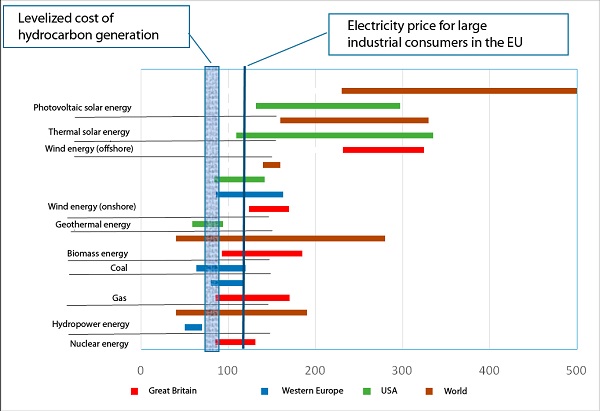
* levelized cost of electricity
Sources:
1) Great Britain: Parsons Brinckerhoff. Powering the Nation Update 2010;
2) Western Europe: Projected Costs of Generating Electricity. 2010 edition. IEA, NEA, 2010;
3) USA: US Environmental Protection Agency Database;
4) World: International Renewable Energy Agency. Renewable Energy Technologies: Cost Analysis Series. Volume 1: Power Sector. Issue 1/5 – 5/5. June 2012.
Obviously, with the exception of hydropower and geothermal energy, all other RES are failing to compete with hydrocarbon power generation to a greater or lesser extent. The economic efficiency of biomass energy production is undermined by increasingly stringent environmental requirements. The EU’s fast-growing wind and solar energy generation is unprofitable (excluding the most sophisticated onshore wind turbines).
As for power generation, almost all EU countries use the so-called feed-in-tariff – a legally imposed obligation on supply/grid companies to buy electricity from renewable energy sources at above market prices.
According to the IEA, except for water resources, the growth of renewable energy depends entirely on subsidies [13]. The majority of the money spent to support renewable energy in Europe has been allocated at the national level. The EU budget directly finances only research and development (R&D) and, in part, certain infrastructure and pilot projects.
Each EU country on its own determines a set of financial methods to support renewable energy. As for power generation, almost all EU countries use the so-called feed-in-tariff – a legally imposed obligation on supply/grid companies to buy electricity from renewable energy sources at above market prices. Apart from this, investment grants, tax incentives, and quotas for the purchase of energy from renewable energy sources are also widespread. All current measures of RES support come down to subsidies that are either directly allocated from state budgets (i.e. financed by taxpayers), or lead to higher wholesale energy prices (i.e. paid for by consumers).
Figures 3 and 4 give an idea of renewable energy subsidies in power generation. As is shown, feed-in-tariffs in a number of EU countries are not just higher than the wholesale price of electricity, but exceed even the final price.
Figure 3.Subsidizing wind energy generation in some EU countries (feed-in-tariff, EUR per megawatt-hour, 2012)
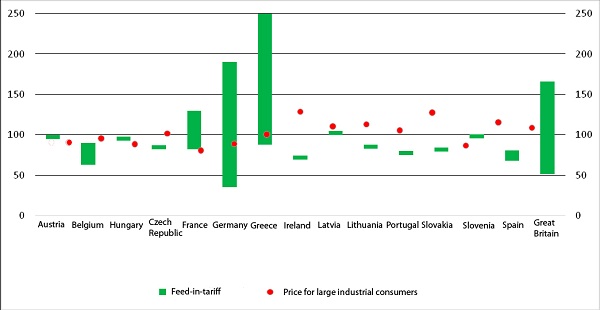
Sources: Eurostat Database ; RES-Legalportal database
According to Euracoal, the RES total subsidy in Germany increased from 1 billion euros in 2000 to 16.8 billion euros in 2011 (Fig. 4), mainly due to support fromthe most expensive types of renewable energy: photovoltaic solar energy, the construction of offshore wind turbines and second-generation biofuels [3]. Illustratively, the subsidy paid for each unit of electricity (kW h) actually doubled from 8.5 ct/kWh to 17.9 ct/kWh. The World Nuclear Association (WNA) estimates subsidies of renewables in Germany to be even higher: the combined subsidy from consumers and government totals about €20 billion per year. According to the WNA, Spain pays subsidies on renewables worth about€7 billion per year [12].
Figure 4.Backing electricity generation from renewable energy sources in Germany*
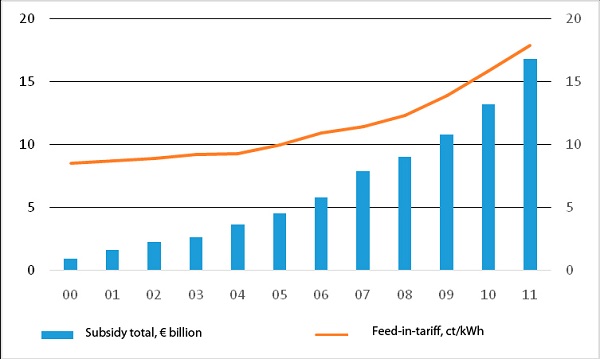
* the combined government subsidy andadditional charge to consumers
Source: [3]
In 2001, the European Environment Agency estimated the total amount of subsidies for the development of renewable energy in the EU 15 at 5.3 billion euros, of which only 0.6 billion euros were on-budget, while the remaining 4.7 billion euros –off-budget [10, p. 14]. The European Commission's draft Communication of November 5, 2013 indicated the figure of 30 billion euros per year [1].
Impact of the Economic Crisis
In an effort to provide citizens and businesses with “safe, sustainable and affordable energy”, the European Union fell into the trap of conflicting goals. Sustainable energy, renewable energy in particular, has been sacrificed in favor of affordable or cheap energy.
Prior to the start of the global financial and economic crisis in 2008-2009, the development of renewable energy in the European Union had been based on large-scale government incentives, including direct support from national budgets (direct subsidies, tax incentives, etc.) and regulatory measures (feed-in tariffs, quota obligations, facilitated access of the electricity produced from renewable energy sources to the electrical grids, etc.). Such regulatory measures were ultimately paid for by energy consumers. The rapid growth of energy production from renewables has led to a similar increase in subsidies. Steady economic growth smoothed over the additional burden placed on energy consumers, and the low cost of money allowed state budgets (and consumers) to finance the growing volume of subsidies for renewable energy generation.
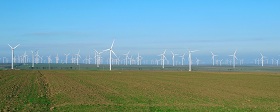
Fântânele-Cogealac (Romania) wind farm is
the largest onshore wind farm in Europe
Once the crisis created an acute shortage of funds for subsidies, a number of EU countries resorted to changing renewable energy support schemes in order to decrease the subsidies. Thus, feed-in-tariffs for photovoltaic solar energy were dramatically reduced in 2011 in the Czech Republic, France and Italy. Spain has been reducing them since 2009. Germany, where the tariffs had been gradually cut throughout the past decade, introduced particularly sharp reductions in 2009 and 2011. This process involved not just solar energy: in 2011, the United Kingdom cut feed-in-tariffs for all types of RES; in 2013, Spain cut the payments for renewables by €1.3-1.4 billion per year [12]. In early 2013, the European Commission stated that many national reforms have had a negative impact on the investment climate in the renewable energy sector. [8, p. 9]
Due to subsidy cuts, power generation from renewable energy sources in the EU decreased in 2011 for the first time in the last 15 years (Table 1). In 20 EU countries, the RES growth rate was negative. Only in four countries (the UK, Belgium, Ireland and Cyprus) was it higher than in previous years, while three countries (Italy, the Netherlands, Poland) managed to hold the line. Characteristically, the largest drop in the production of renewable energy in 2011 was observed in those EU countries which had previously lagged behind other EU member-states in terms of the average renewable energy development. The deepest decline took place in France (-13.2 percent), Romania (-11.9 percent) and Slovenia (-11.3 percent). Total production of renewable energy in the EU in 2011 fell by 2.7 percent, primarily due to biomass and hydropower, which together account for more than 80% percent of renewable electricity generation (Table 1).
Table 1.Development of renewable energy: countries’ reaction to the economic crisis
| Primary production of renewable energy: the growth rate in 2011 | Primary production of renewable energy: average growth rate in 2006-2010 | |
|---|---|---|
| Rapid (above the average for the EU-27) | Slow(below the average for the EU-27) | |
| Negative | Bulgaria, Germany, Spain, Portugal, Slovakia, Estonia (-3,6) | Austria, Hungary , Greece , Denmark, Latvia, Lithuania, Luxembourg, Malta , Romania, Slovenia , Finland, France , Sweden (-6,0) |
| Declined | The Czech Republic (4,6) | |
| Stable | Italy, Netherlands, Poland (8,3) | |
| Increased | Belgium, Ireland, Cyprus, United Kingdom (19,8) | |
*Figures in brackets indicate the growth rate of primary production of renewable energy in 2011, %.
Source: Eurostat Database
However, solar and wind power generation continued to grow at a fairly quick rate. Moreover, in 2010-2012 quite a few new generating installations were commissioned (although, not as many as had been expected). However, this development was largely due to its own inertia. The usually optimistic EWEA report notes: The stress felt in many markets across Europe throughout the wind industry’s value chain should become apparent in a reduced level of installations in 2013, possibly continuing well into 2014 [11].
Changing Priorities of the European Union
In 2013 the attitude of the European Commission towards developing and subsidizing renewable energy underwent significant changes. Thus, in 2011, a Communication from the Commission to the European Parliament and the Council [7, pp. 8, 14] called for doubling capital investment in renewable energy from 35 to 70 billion euros per year in order to achieve the stated objectives. And in March 2013, the Commission spoke about the need to reform support schemes to ensure that they were designed in a cost-effective, market-oriented manner. [8, p. 9]. However, at that time the Commission's position was still a compromise.
The summit of the European Council held on May 22nd, 2013 was the turning point. The meeting declared the change in the EU energy policy priorities at the political level and the replacement of “sustainable energy” with “competitive energy.”
The change in priorities is clearly demonstrated by the opening phrase of the European Council Conclusions: “In the current economic context we must mobilize all our policies in support of competitiveness, jobs and growth.”
The European Council demanded a move “to revise state aid rules” on power generation, concentrating on “phasing out environmentally or economically harmful subsidies” and developing “efficient and cost-effective support schemes for renewable energies.”The paper emphasizes that “cost-effectiveness, further market integration and grid stability” are crucial for the further development of renewable energy generation [9].
Pursuant to the European Council decision of November 5, 2013, the Commission issued a Communication on future principles of support-schemes for renewable and launched extensive consultations with all concerned actors [5]. The Commission's proposals assume two ideas as starting points: 1) a reduction in subsidies for renewable energy, and 2) support for gas and coal power generation in order to provide reserve capacity in the power supply system. “It is important that production and investment decisions are driven increasingly by the market and not by guaranteed price levels determined by public authorities. Any support that is still necessary should therefore supplement market prices, not replace them, and be limited to the minimum needed.” [5, p. 15].
As for specific measures, the Commission proposes phasing out feed-in tariffs and replacing them with feed-in premiums and other support instruments, which will force producers to respond to market prices [i].
***
The decision of the European Council on the subsequent actions of the Commission makes significant adjustments to the priorities of EU energy policy. They indicate a decline in the attention paid to climatic aspects of the energy sector and a revision of RES accelerated development strategy. Henceforth, the main concern of the EU in the energy sector is the price of energy supply.
Despite certain differences among the EU countries, it is reasonable to expect abolishing “economically harmful subsidies” and switching over to “economically sound” support schemes for renewable energy. This change in the strategy is mainly based on the recognition that the development of renewable energy has been accompanied by a number of problems. Thus, huge expenses bear heavily on state budgets and final consumers. Emerging threats to security and reliability of power systems were another incentive to revise the strategy of renewable energy development.
In an effort to provide citizens and businesses with “safe, sustainable and affordable energy” [6], the European Union fell into the trap of conflicting goals. Today it is obvious that sustainable energy, renewable energy in particular, has been sacrificed in favor of affordable or cheap energy. As a result, this will lead to a dramatic reduction in the growth of renewable energy in the EU.
Given the curtailment of nuclear energy generation in several EU countries, including Germany, we have every reason to believe that hydrocarbons will maintain their leading position in the energy mix of the EU. The EU needs for imported oil, gas and coal will obviously be greater than the current forecasts of the European Commission suggest. The politically motivated intentions of the EU to reduce dependence on oil supplies from Russia contravene economic realities that require increased imports.
References
1. Bulletin quotidien Europe, № 10957. 6.11.2013.
2. Directive 2009/28/EC of 23 April 2009 on the promotion of the use of energy from renewable sources.
3. Euracoal. Annual report 2012.
4. European Commission. Communication. An Energy Policy for Europe. COM (2007) 1 final.
5. European Commission. Communication. Delivering the internal electricity market and making the most of public intervention. C(2013) 7243 final. 5.11.2013.
6. European Commission. Communication. Energy 2020. A strategy for competitive, sustainable and secure energy. COM (2010) 639 final, 10.11.2010.
7. European Commission. Communication. Renewable Energy: Progressing towards the 2020 target. COM (2011) 31 final. 31.1.2011.
8. European Commission. Report. Renewable energy progress report. COM(2013) 175 final. 27.3.2013.
9. European Council Conclusions, 22 May 2013. EUCO 75/1/13 REV 1
10. European Environment Agency. Energy subsidies in the European Union: A brief overview. EEA Technical report 1/2004.
11. EWEA. Wind in power 2012 European statistics. February 2013.
12. World Nuclear Association. Energy Subsidies and External Costs. Updated October 2013.Accessed 10.01.2014, http://www.world-nuclear.org/info/Economic-Aspects/Energy-Subsidies-and-External-Costs/
13. IEA. Presentation of World Energy Outlook 2013. Moscow, November 25, 2013
i. Feed-in-tariffsare a legally imposed obligation on supply/grid companies to buy electricity from renewable energy sources at above market prices. The size of a feed-in-tariff is usually fixed 10-20 years ahead. This shields renewable energy producers from market price signals and removes incentives for reducing costs. Feed-in-premiums are a legally imposed obligation on supply/grid companies to pay the market price and, in addition, a premium of a fixed size, when buying electricity from renewable energy sources.
(votes: 1, rating: 5) |
(1 vote) |


